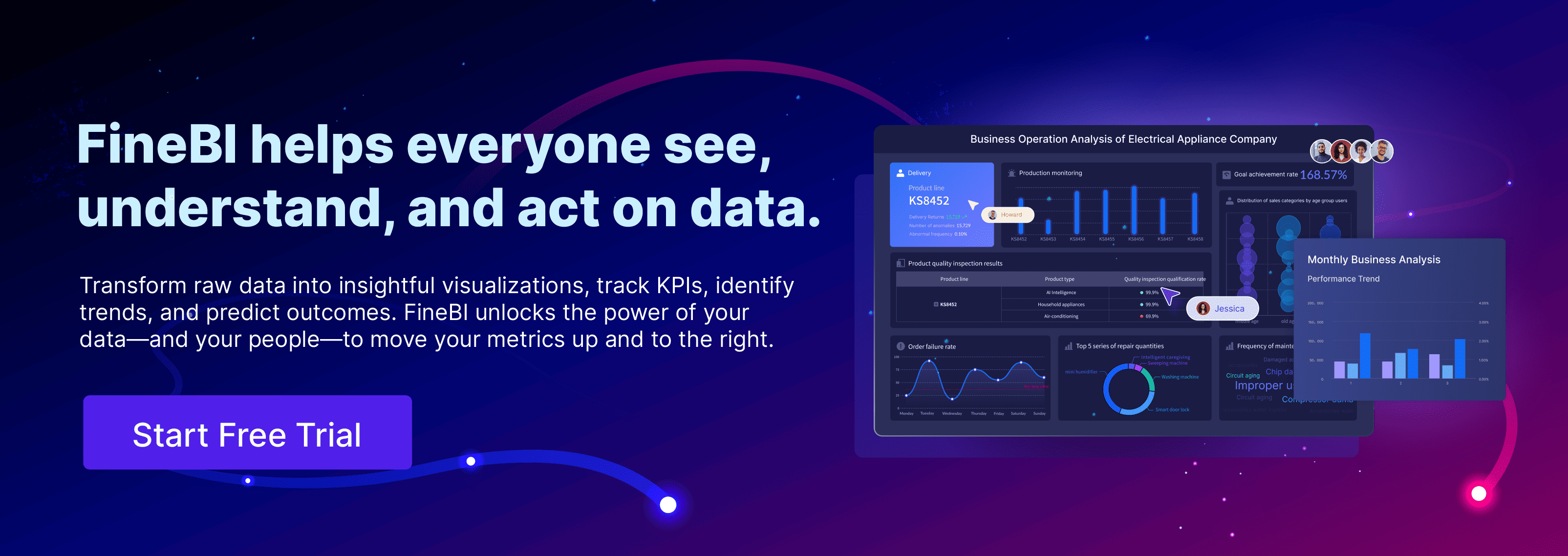In 2025, predictive analytics tools will redefine how businesses operate. These tools empower you to anticipate market shifts, optimize operations, and make informed decisions. The global predictive analytics market is expected to grow from $10.5 billion in 2021 to $28.1 billion by 2026, highlighting the increasing reliance on real-time insights. Companies leveraging predictive analytics tools often achieve faster decision-making and cost savings, as noted by Harvard Business Review.
As insurers increasingly rely on AI-powered decision-making, there is a growing emphasis on ensuring these systems are transparent, unbiased, and accountable.
Adopting predictive analytics tools ensures you stay competitive in a landscape driven by data and analytics. With trends like ethical AI and real-time data utilization gaining momentum, businesses must embrace these innovations to thrive.the following is the Top Predictive Analytics Tools:
- FineBI
- Alteryx AI
- IBM Watson Studio
- H2O Driverless AI
- Dataiku

Key Takeaways on Predictive Analytics Tools
- Boost Decision-Making: Predictive tools enable faster, smarter choices, saving costs and keeping businesses competitive.
- Key Features Matter: Choose tools that are accurate, user-friendly, and scalable, integrating them seamlessly into existing systems.
- Customer Insight and Trials: These tools enhance customer understanding for personalized experiences, while free trials ensure the right fit before investment.

What Are Predictive Analytics Tools?
Definition of Predictive Analytics Tools
Predictive analytics tools are software solutions that use statistical techniques, machine learning algorithms, and data mining to analyze historical data and predict future outcomes. Unlike descriptive analytics, which focuses on understanding past events, predictive analytics helps you anticipate what might happen next. These tools empower businesses to forecast trends, optimize operations, and make data-driven decisions.
For example, predictive analytics tools can help you identify customer behavior patterns, detect fraud, and improve resource allocation. They are essential for businesses aiming to stay competitive in a data-driven world.
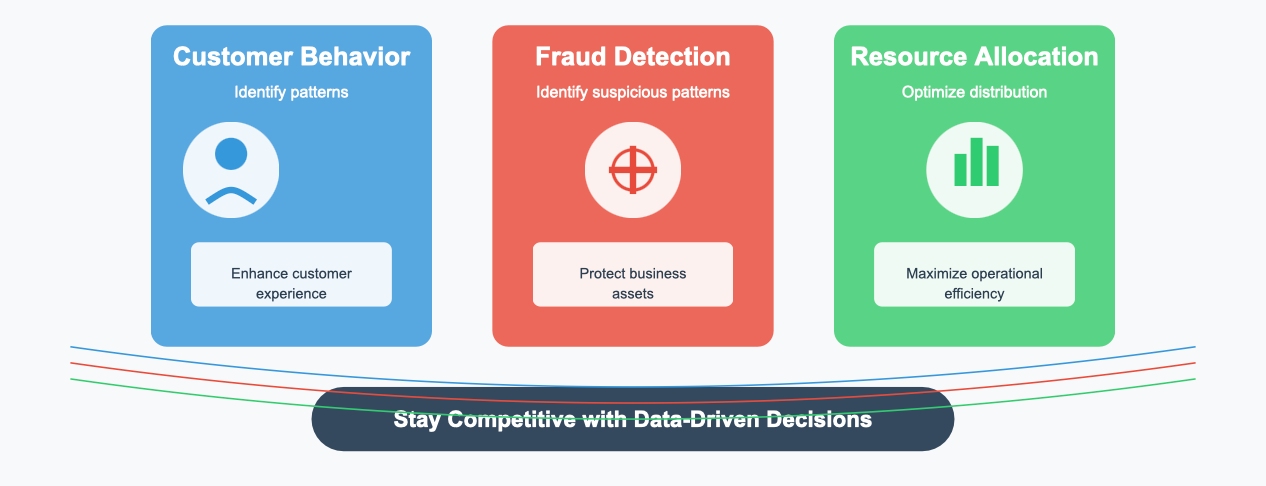
Key types of predictive analytics tools include:
- Predictive modeling tools
- Data mining tools
- Statistical analysis software
- Machine learning platforms
- Visualization tools
How Predictive Analytics Tools Work
Predictive analytics tools process data by integrating information from various sources, uncovering patterns, and generating forecasts. They rely on advanced analytics techniques like machine learning and statistical modeling to analyze complex datasets.
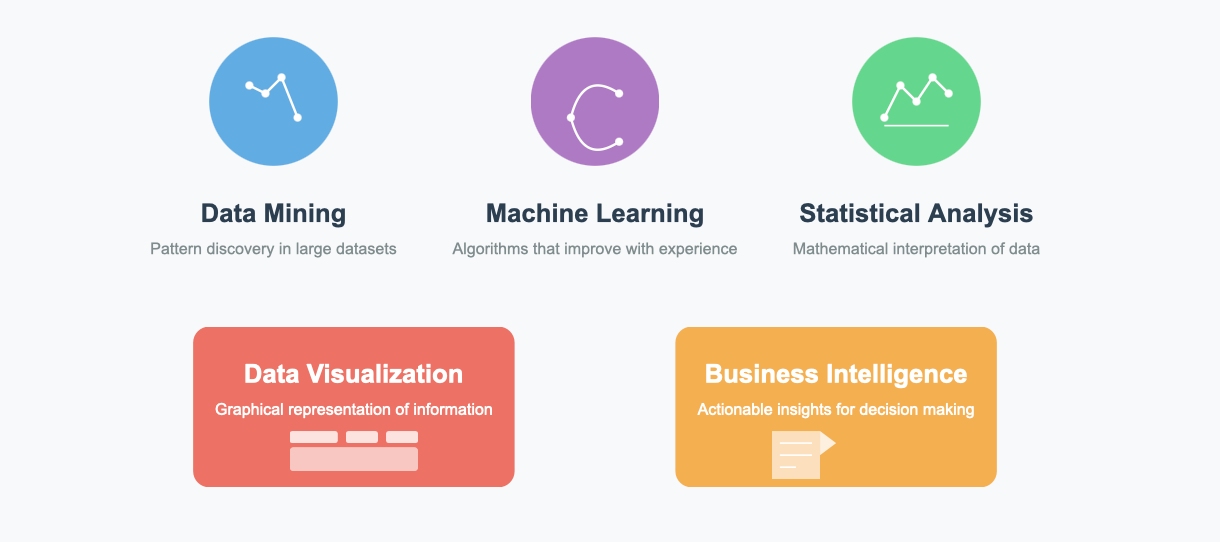
Here’s how these tools typically work:
- Data Integration: They collect and consolidate data from multiple sources, such as databases, cloud platforms, and on-premises systems.
- Data Analysis: Using predictive modeling techniques, they analyze historical data to identify trends and patterns.
- Forecasting Models: These tools create forecasting models to predict future outcomes, such as sales growth or customer churn.
- Visualization: They present insights through interactive dashboards and charts, making it easier for you to understand and act on the data.
For instance, a predictive analytics platform might use machine learning tools to analyze customer purchase history and predict future buying behavior. This capability allows businesses to tailor their marketing strategies and improve customer satisfaction.
Why Predictive Analytics Tools Are Crucial for Businesses in 2025
In 2025, predictive analytics tools will play a pivotal role in business success. They provide actionable insights that help you improve operations, develop strategic plans, and stay ahead of competitors.
These tools are particularly valuable for:
- Business Forecasting: They enable you to anticipate market trends and make informed decisions.
- Fraud Prevention: Predictive analytics capabilities help detect anomalies and prevent fraudulent activities.
- Resource Optimization: By analyzing data, these tools ensure efficient allocation of resources.
- Customer Insights: They allow you to understand customer behavior and personalize experiences.
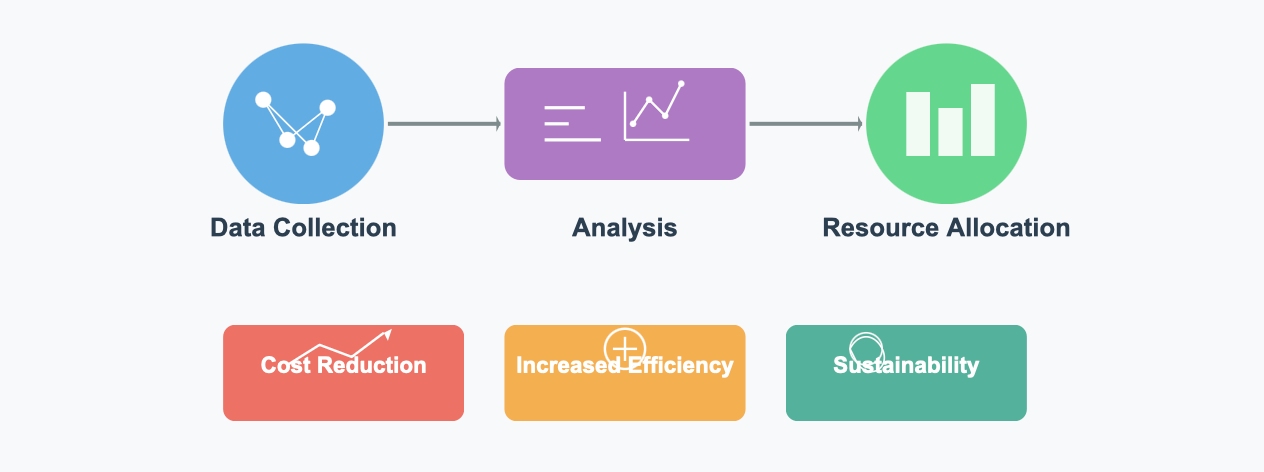
The predictive analytics market is expected to grow significantly, with a projected value of $20.77 billion in 2025 and a revenue forecast of $52.91 billion by 2034. This growth highlights the increasing reliance on predictive analytics software across industries like healthcare, retail, and manufacturing.
Pro Tip: To explore how predictive analytics workflows can transform your business, visit FineBI's official documentation.
By adopting the best predictive analytics tools, you can harness advanced analytics capabilities to drive innovation and achieve your business goals.
Benefits of Predictive Analytics Tools

Improved Decision-Making
Predictive analytics tools empower you to make smarter decisions by providing actionable data insights. These tools analyze historical data and use predictive models to forecast future outcomes. For example, in the real estate industry, Zillow uses predictive analytics software to enhance property valuations and predict market trends. This approach improves accuracy and helps businesses stay ahead of market changes.
| Industry | Company | Overall Impact | Key Learnings |
|---|---|---|---|
| Sports | N/A | Improved player performance and team success through data-driven training. | Data-driven insights enhance player development and game strategy. |
| Real Estate | Zillow | Enhanced accuracy in property valuations and market trend predictions. | Incorporating multiple data sources improves predictive accuracy. |
| Manufacturing | Siemens | Reduced operational disruptions through proactive maintenance scheduling. | Predictive maintenance minimizes unplanned downtimes. |
| Media | Spotify | Increased user engagement through personalized music recommendations. | Personalization enhances user experience and satisfaction. |
| Education | Pearson | Improved student performance and reduced dropout rates through targeted interventions. | Early identification of at-risk students allows for timely interventions. |
This table highlights how predictive analytics use cases span industries, showcasing their ability to drive data-driven decision-making. By leveraging predictive analytics capabilities, you can anticipate challenges and seize opportunities with confidence.
Enhanced Operational Efficiency
Predictive analytics tools streamline operations by optimizing processes and reducing inefficiencies. These tools use predictive modeling to identify patterns and forecast potential disruptions, enabling you to act proactively. For instance, Siemens employs predictive analytics to schedule maintenance, reducing unplanned downtimes and improving operational efficiency.
Companies using predictive analytics report measurable improvements, as shown below:
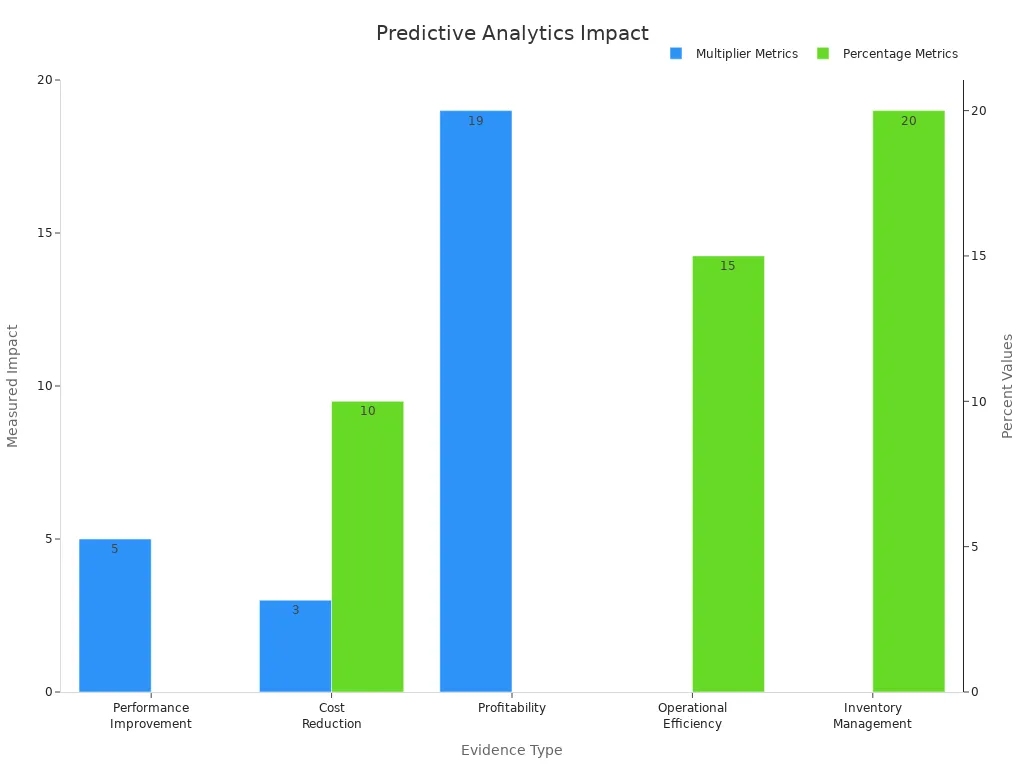
- A retail chain reduced excess stock by 20% using machine learning algorithms for inventory forecasting.
- Organizations adopting predictive analytics are three times more likely to achieve significant cost reductions.
- Businesses report a 15% increase in operational efficiency after implementing predictive analytics tools.
These trends demonstrate how predictive analytics platforms enhance productivity and reduce costs, making them essential for modern businesses.
Better Customer Insights and Personalization
Predictive analytics tools provide deep customer experience insights, enabling you to tailor your offerings to individual preferences. By analyzing customer behavior, these tools help you predict future needs and deliver personalized experiences. For example, Spotify uses predictive analytics to recommend music based on user preferences, increasing engagement and satisfaction.
| Evidence Type | Description |
|---|---|
| Market Growth Forecast | The predictive analysis market is expected to reach 42.52 billion USD by 2028, indicating significant investment in these tools. |
| User Expectation | Users expect personalized treatment, which predictive analytics can provide, enhancing customer experience. |
| Adoption Rate | 53% of marketing leaders are using or planning to adopt AI for predictive analytics, showing a trend towards personalization. |
These insights highlight the growing demand for predictive analytics tools in delivering personalized customer experiences. By adopting these tools, you can enhance customer loyalty and drive business growth.
Pro Tip: Explore how FineBI can help you unlock customer experience insights with its advanced analytics capabilities. Visit FineBI's official documentation to learn more.

Risk Mitigation and Fraud Detection
Predictive analytics tools have become indispensable for businesses aiming to mitigate risks and detect fraud effectively. These tools analyze vast amounts of data to uncover patterns, anomalies, and potential threats before they escalate into significant issues. By leveraging advanced analytics, you can safeguard your organization against financial losses and reputational damage.
Fraud detection is one of the most impactful applications of predictive analytics. For instance, insurance companies use these tools to assess risks and identify fraudulent claims. By analyzing patterns in claims data, predictive models can flag anomalies that indicate potential fraud. This proactive approach not only saves money but also ensures fair treatment for genuine customers.

In addition to traditional methods, innovative techniques are emerging. A 2023 study by Fan et al highlights the use of sentiment analysis on news articles to predict fraud risks before they appear in financial statements. This method provides early warnings for investors and regulators, enabling them to act swiftly. Such advancements demonstrate how predictive analytics continues to evolve, offering new ways to address complex challenges.
Risk mitigation extends beyond fraud detection. Predictive analytics tools help businesses anticipate operational risks, such as supply chain disruptions or equipment failures. By analyzing historical trends and real-time data, these tools enable you to prepare for potential issues. For example, manufacturers can use predictive models to schedule maintenance, reducing the likelihood of costly downtimes.
The financial sector also benefits significantly from predictive analytics. Banks and financial institutions use these tools to evaluate credit risks, ensuring responsible lending practices. By analyzing customer data, they can identify high-risk profiles and make informed decisions. This approach not only minimizes defaults but also enhances overall financial stability.
To maximize the benefits of predictive analytics, you need tools that integrate seamlessly with your existing systems. FineBI, for example, offers advanced analytics capabilities that empower you to analyze data efficiently and gain actionable insights. Whether you aim to detect fraud or mitigate risks, tools like FineBI provide the foundation for informed decision-making. Learn more about its features by visiting FineBI's official documentation.

By adopting predictive analytics, you can stay ahead of emerging trends and protect your business from unforeseen challenges. These tools not only enhance operational resilience but also contribute to a safer and more transparent business environment.
Key Features to Consider When Choosing Predictive Analytics Tools
Accuracy and Reliability
When selecting predictive analytics tools, accuracy and reliability should top your list of priorities. These tools must deliver precise forecasts and consistent results to support your decision-making processes. Inaccurate predictions can lead to costly mistakes, such as overestimating demand or misallocating resources. Reliable tools ensure that the insights you derive from your data remain dependable, even as your datasets grow or change.
Accuracy often depends on the tool's machine learning integration. Advanced algorithms analyze historical data to uncover patterns and trends, enabling you to make informed decisions. For example, tools with robust predictive analytics capabilities can identify subtle anomalies in customer behavior, helping you anticipate churn or fraud. Consistency in results builds trust in the tool, allowing you to confidently act on its recommendations.
Scalability for Growing Businesses
As your business grows, your data and analytics needs will expand. A scalable predictive analytics tool ensures that it can handle increasing data volumes and complexity without compromising performance. Whether you're a startup or an established enterprise, scalability allows you to adapt to evolving business requirements and market trends.
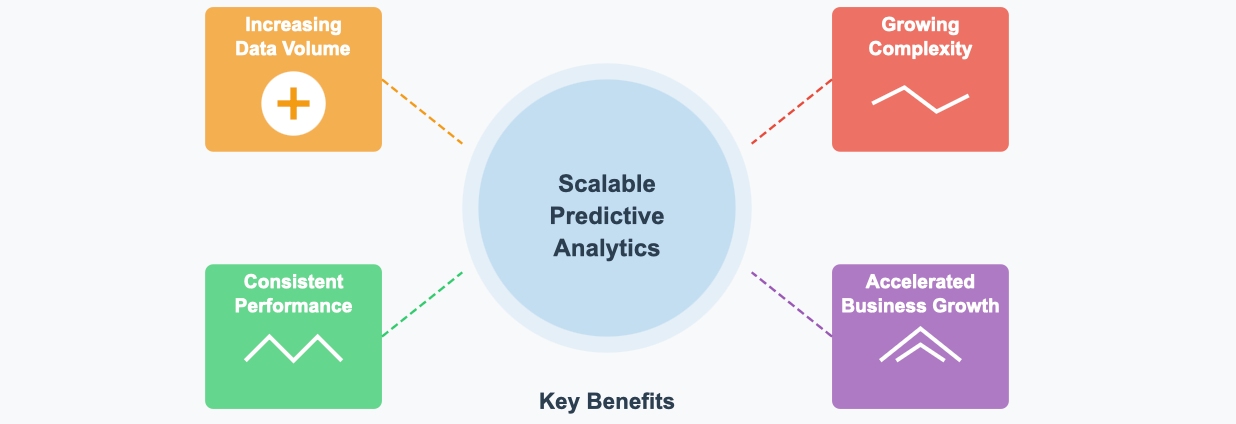
Scalable tools often feature cloud-based architectures, enabling seamless integration with your existing systems. They also support advanced analytics capabilities, such as real-time data processing and machine learning integration, which are essential for businesses aiming to stay competitive. For instance, a retail chain might start by analyzing regional sales data but later expand to include global trends and customer segmentation. A scalable tool grows with your business, ensuring you can continue to derive data-driven insights as your operations evolve.
User-Friendliness and Accessibility
User-friendliness and accessibility are critical for ensuring that predictive analytics tools can be used effectively across your organization. Tools with intuitive interfaces democratize data access, allowing team members from various departments to engage with analytics without requiring extensive technical training. This accessibility fosters a data-driven culture, where employees at all levels can contribute to decision-making.
Key features that enhance user-friendliness include streamlined workflows, interactive dashboards, and data visualization tools. These features simplify complex analytics processes, enabling users to navigate the platform efficiently and derive meaningful insights. For example, visualization tools help you comprehend data trends at a glance, making it easier to identify opportunities or address challenges.

Additionally, accessible tools often include role-based permissions, ensuring that sensitive data remains secure while empowering users to explore relevant analytics. By choosing a tool that prioritizes user experience, you can maximize its adoption and impact across your organization. To explore how user-friendly tools like FineBI can transform your analytics workflows,
If you want to know more, visit FineBI's official documentation here!
Integration with Existing Systems
Integrating predictive analytics tools with your existing systems ensures seamless workflows and maximizes operational efficiency. These tools are designed to unify data from various sources, such as databases, CRM platforms, and ERP systems, enabling you to leverage their full capabilities without disrupting your current processes.
Most predictive analytics tools offer APIs and pre-built connectors that facilitate smooth data flow between systems. This compatibility enhances their effectiveness by allowing you to access and analyze data in real time. For example:
- APIs enable predictive analytics tools to gather and preprocess data from multiple sources, ensuring accuracy and consistency.
- Integration with CRM systems helps you gain deeper customer insights, while ERP integration optimizes resource planning.
- AI services embedded in these tools enhance operational efficiency by automating repetitive tasks and providing actionable insights.
Choosing tools that prioritize ease of use and scalability is essential. Scalable solutions grow with your business, adapting to increasing data volumes and complexity. Moreover, integration should occur with minimal disruption to your workflows, ensuring a smooth transition. By aligning predictive analytics tools with your existing tech stack, you can unlock their full potential and stay ahead of industry trends.
Pro Tip: FineBI offers seamless integration with various systems, making it an ideal choice for businesses looking to enhance their analytics capabilities. Explore its features at FineBI's official documentation.
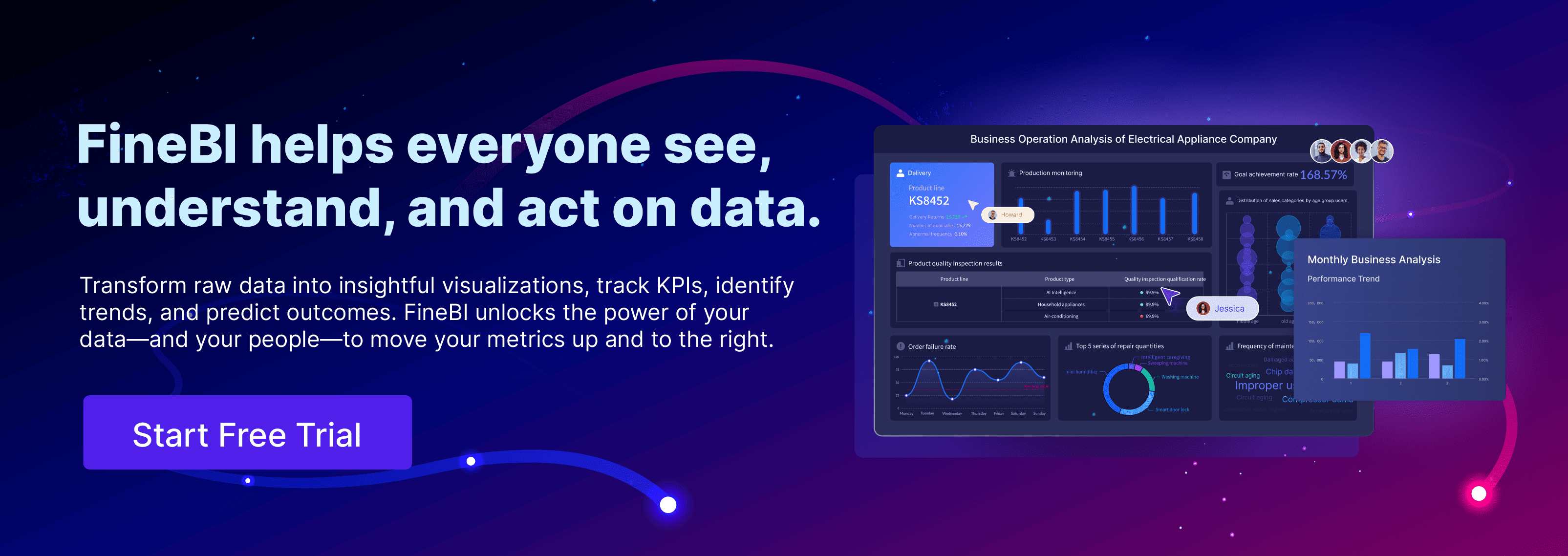
Cost-Effectiveness and ROI
When evaluating predictive analytics tools, understanding their cost-effectiveness and return on investment (ROI) is crucial. These tools come in various pricing plans, each offering unique features to suit different business needs. Here's a breakdown of typical pricing structures:
| Plan Type | Average Price | Common Features |
|---|---|---|
| Free Plan | $0 | Basic data visualization, limited data storage, and community support. |
| Personal Plan | $10-$30/user/month | Advanced data visualization, predictive modeling, and basic reporting tools. |
| Business Plan | $50-$100/user/month | Real-time analytics, data integration capabilities, and customizable dashboards. |
| Enterprise Plan | $150-$300/user/month | Comprehensive data management, AI-driven insights, and dedicated customer support. |
Investing in predictive analytics tools can yield significant ROI by improving decision-making, enhancing operational efficiency, and reducing costs. For instance, tools with machine learning integration can analyze trends and predict outcomes, helping you optimize inventory or prevent fraud. Businesses adopting these tools often report measurable benefits, such as a 15% increase in efficiency and a 20% reduction in operational costs.
To maximize ROI, select tools that align with your business goals and offer features tailored to your needs. Tools like FineBI provide advanced analytics capabilities at competitive pricing, ensuring you achieve both cost-effectiveness and high ROI.
You can try it out in the FineBI demo model below:
Top Predictive Analytics Tools for 2025

1.FineBI by FanRuan
Key Features
FineBI by FanRuan stands out as a self-service business intelligence tool designed to simplify data analysis and data visualization. It supports integration with over 100 data sources, including relational databases, big data platforms, and NoSQL databases. FineBI offers real-time data analysis, augmented analytics, and role-based access control, ensuring secure and efficient workflows. Its drag-and-drop interface makes it accessible to users without technical expertise, while its OLAP analysis capabilities allow for dynamic filtering, drill-downs, and cross-theme analysis.
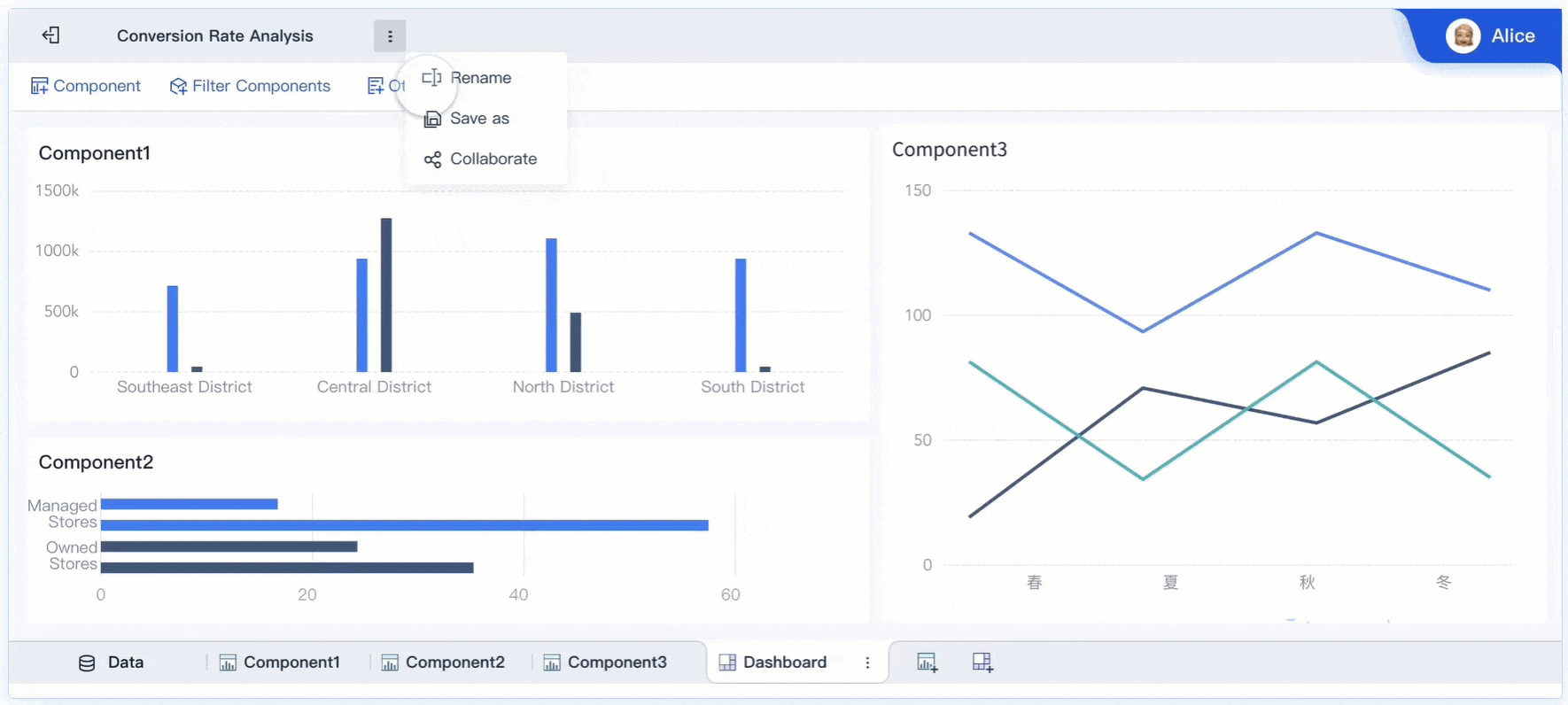
Pros and Cons
Pros:
- User-friendly interface suitable for non-technical users.
- Real-time analytics capabilities enhance decision-making speed.
- Supports large-scale data processing with high-performance computing.
Cons: Advanced features may require additional training for optimal use.
Ideal Use Cases
FineBI is ideal for businesses seeking to democratize data access and empower teams with self-service analytics. It excels in industries like retail, manufacturing, and finance, where real-time insights and predictive analytics use cases drive operational efficiency. Learn more about its features at FineBI's official documentation.
2.Alteryx AI Platform
Key Features
The Alteryx AI Platform simplifies complex analytics processes with automated data preparation and self-service tools. It offers a comprehensive suite of predictive analytics tools, including machine learning integration and advanced data mining capabilities. Its visual workflows enable users to build predictive models without coding, making it accessible to a wide range of professionals.

Website: https://www.alteryx.com/
Pros and Cons
Pros:
- Intuitive interface with drag-and-drop functionality.
- Strong automation features reduce manual effort.
- High user satisfaction, with 95% positive sentiment.
Cons: Pricing may be a barrier for smaller businesses.
Ideal Use Cases
Alteryx is perfect for organizations aiming to streamline analytics workflows and enhance predictive modeling. It suits industries like healthcare and logistics, where data-driven decisions are critical.
Metric | Rating |
|---|---|
Overall Rating | 7.5/10 |
Likeliness to Recommend | 85 |
Plan to Renew | 95 |
Satisfaction of Cost Relative to Value | 75 |

3.IBM Watson Studio
Key Features
IBM Watson Studio integrates a broad range of analytics functions, including machine learning, data visualization, and collaborative tools. It supports both code-based and visual interfaces, catering to diverse user needs. Its cloud-based architecture ensures scalability and seamless integration with existing systems.
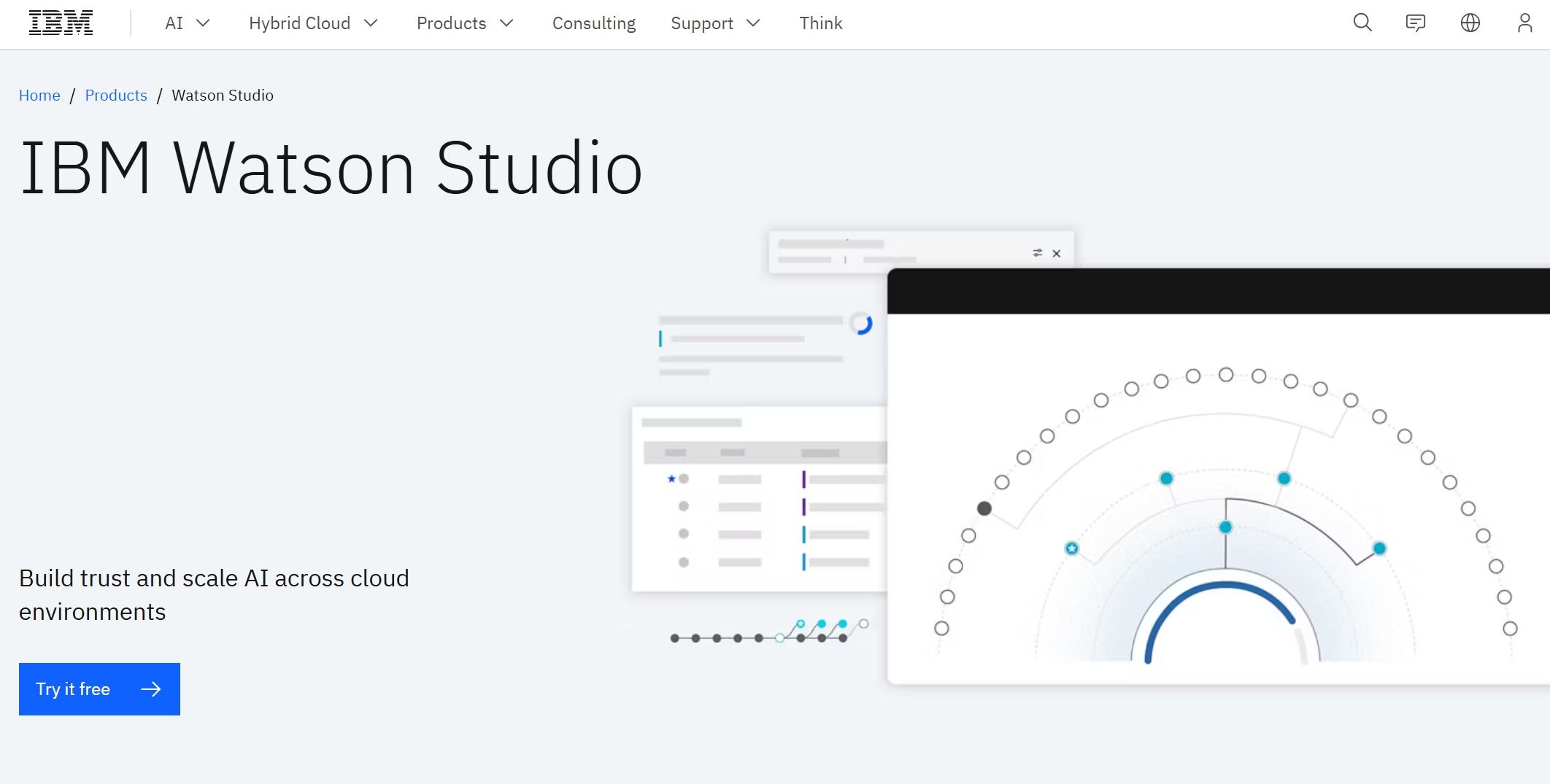
Website: https://www.ibm.com/products/watson-studio
Pros and Cons
Pros:
- Robust analytics capabilities for advanced users.
- Strong focus on collaboration and team workflows.
- Scalable solutions for businesses of all sizes.
Cons: Steeper learning curve for non-technical users.
Ideal Use Cases
IBM Watson Studio is well-suited for enterprises requiring advanced predictive analytics tools for large-scale projects. It is particularly effective in industries like finance and telecommunications, where data complexity demands powerful analytics solutions.
4.H2O Driverless AI

Key Features
H2O Driverless AI is a cutting-edge platform designed to simplify predictive analytics for businesses. It automates many aspects of machine learning, including feature engineering, model selection, and hyperparameter tuning. This automation reduces the time and expertise required to build accurate predictive models.
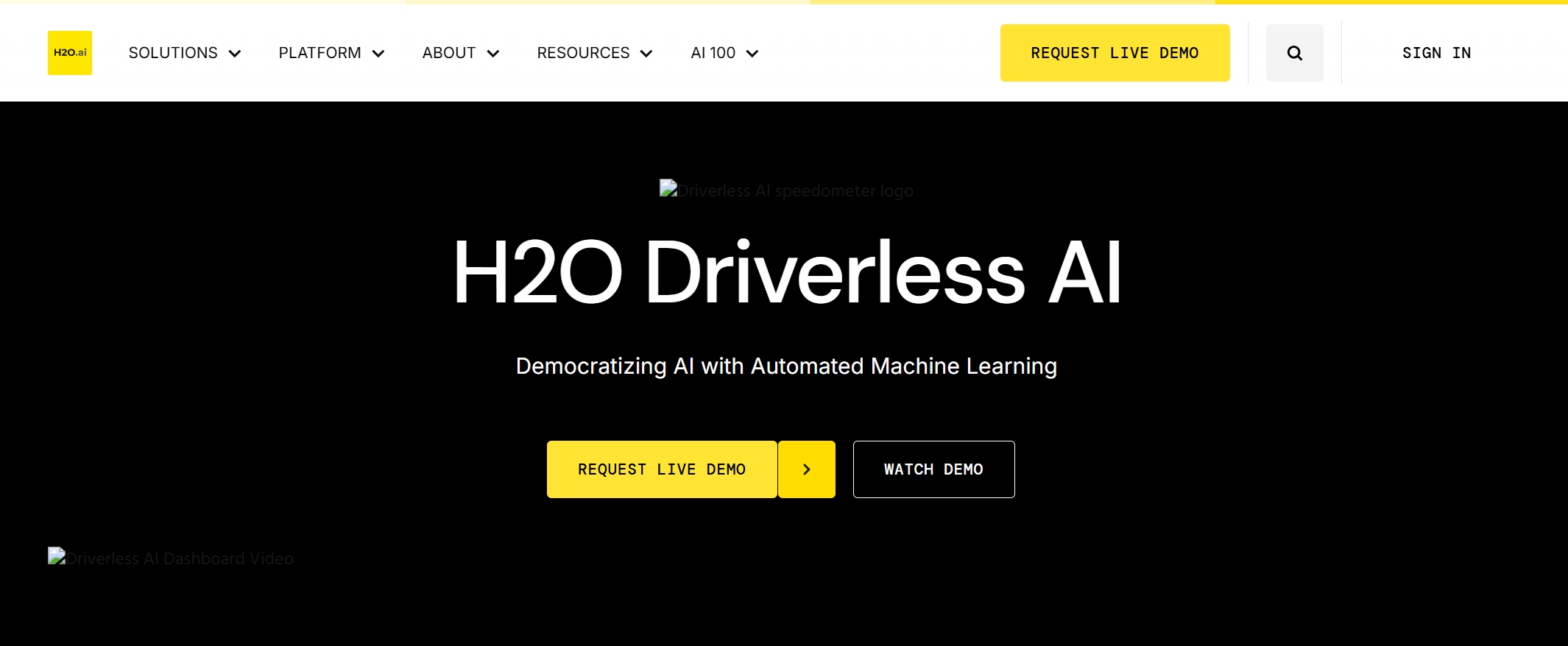
Website: https://h2o.ai/platform/ai-cloud/make/h2o-driverless-ai/
Key features include:
- AutoML Capabilities: Automatically selects the best algorithms and optimizes models for high accuracy.
- Explainable AI: Provides detailed explanations of model predictions, ensuring transparency and trust.
- Time Series Support: Handles time-based data effectively, making it ideal for forecasting trends.
- Scalability: Processes large datasets efficiently, catering to businesses of all sizes.
- Integration: Seamlessly integrates with popular analytics platforms and programming languages like Python and R.
Pros and Cons
Pros:
- Reduces the need for extensive data science expertise.
- Speeds up the development of predictive models.
- Offers robust tools for explainability and compliance.
Cons:
- May require additional resources for initial setup.
- Advanced features might overwhelm beginners.
Ideal Use Cases
H2O Driverless AI is perfect for industries that rely on predictive analytics to make data-driven decisions. Retailers can use it to forecast demand and optimize inventory. Financial institutions benefit from its fraud detection capabilities. Healthcare providers can leverage it for patient outcome predictions.
For businesses seeking to explore predictive analytics tools that simplify workflows, H2O Driverless AI offers a powerful solution.
5.Dataiku

Key Features
Dataiku stands out as one of the best predictive analytics tools for its versatility and user-friendly design. It supports the entire data pipeline, from preparation to deployment, making it a comprehensive solution for businesses.
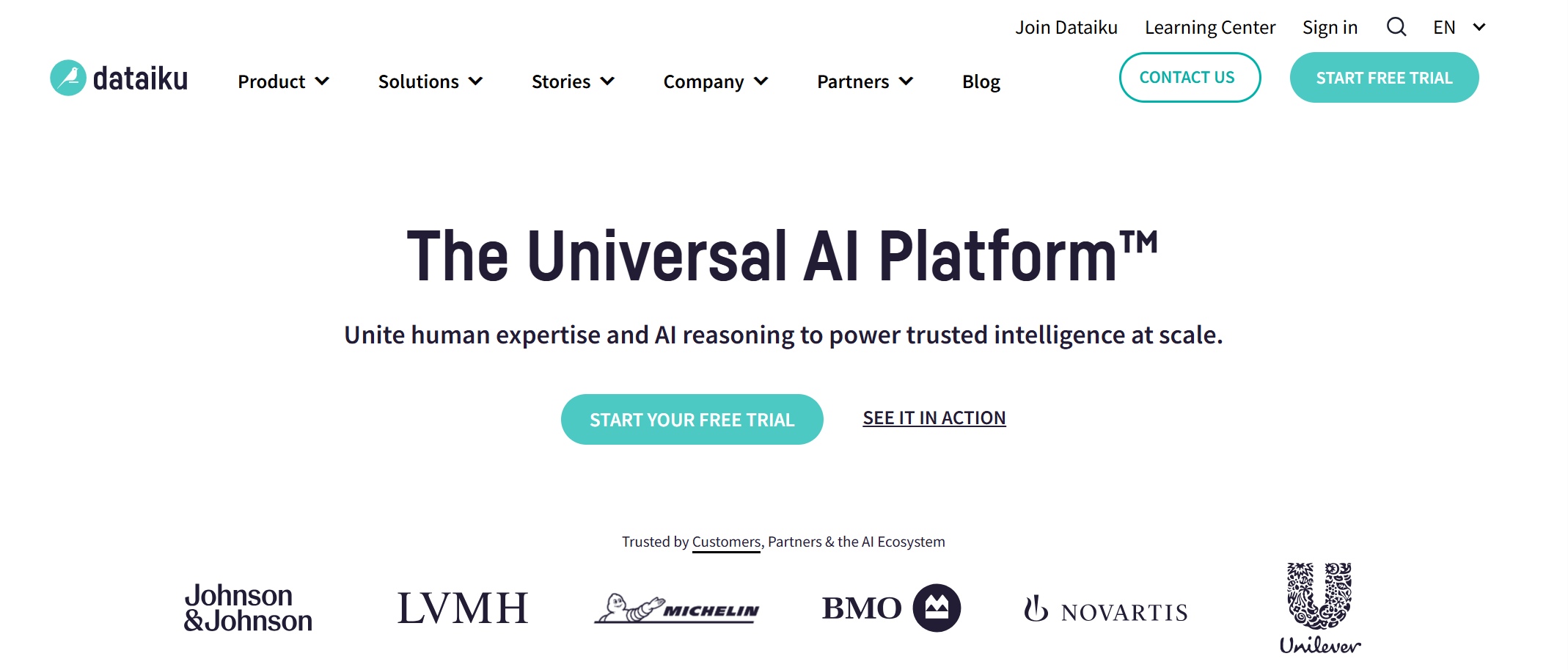
Website: https://www.dataiku.com/
| Feature | Description |
|---|---|
| Sampling and Pre-filtering | Enables exploratory data analysis on manageable subsets, identifying trends without processing the entire dataset. |
| Data Quality Metrics | Provides immediate insights into data quality, helping monitor consistency and identify outliers. |
| Dataset Preview | Allows users to inspect data at various workflow stages, ensuring correct transformations and calculations. |
| Predictive Modeling Tools | Offers a comprehensive suite for model building, supporting various ML algorithms and AutoML for ease of use. |
| Model Evaluation Metrics | Ensures accurate assessment of model performance with extensive visualization tools. |
| Seamless Deployment | Facilitates real-time scoring and integration with operational systems for effective model deployment. |
Pros and Cons
Pros:
- Intuitive interface suitable for both technical and non-technical users.
- Comprehensive tools for data preparation and predictive modeling.
- Strong focus on collaboration, enabling teams to work together seamlessly.
Cons:
- May require significant computational resources for large-scale projects.
- Advanced features might have a learning curve for new users.
Ideal Use Cases
Dataiku is ideal for businesses looking to streamline their analytics workflows. It excels in industries like manufacturing, where analyzing production trends can improve efficiency. Retailers can use it to enhance customer segmentation and personalize marketing strategies. Financial institutions benefit from its ability to process large datasets and build accurate predictive models.
For organizations seeking the best predictive analytics tools, Dataiku offers a robust platform that adapts to diverse business needs.
Pro Tip: Explore how FineBI can complement tools like Dataiku by providing advanced analytics capabilities. Visit FineBI's official documentation to learn more.
How to Choose the Right Predictive Analytics Tool for Your Business
Assessing Your Business Needs
Choosing the right predictive analytics tool starts with understanding your business needs. Begin by identifying the specific goals you want to achieve. For example, are you looking to improve sales forecasting, optimize supply chain operations, or enhance customer personalization? Clearly defining your objectives will help you narrow down the best solution for your organization.

Involve stakeholders from different departments to gain a comprehensive understanding of the challenges you face. For instance, your marketing team might need insights into customer behavior, while your operations team may focus on predictive maintenance. Articulating these needs ensures the tool you select aligns with your overall business strategy.
Use an analytical framework to guide your decision-making process. The table below outlines key considerations:
| Framework/Consideration | Description |
|---|---|
| Defining Use Cases | Helps narrow down the best solution based on specific business needs. |
| Technical Requirements | Assess whether advanced AI models or user-friendly solutions are needed based on team expertise. |
| Budget and Resource Planning | Evaluate costs against potential ROI, considering the range of tools available. |
| Implementation and Training Requirements | Factor in the time and resources needed for onboarding and setup of the tool. |
| Integration with Existing Systems | Ensure compatibility with current tech stack, including CRM and ERP systems. |
| Vendor Evaluation Criteria | Consider vendor reputation, support, and usability through trials and demos. |
By following this framework, you can align your choice with your business goals and ensure the tool delivers value.
Evaluating Vendor Support and Training

Vendor support and training play a crucial role in the successful adoption of predictive analytics tools. Look for vendors that offer comprehensive services, including consulting, integration, and ongoing support. These services ensure a smooth implementation process and help your team maximize the tool's potential.
Training programs are equally important. Predictive analytics tools often come with advanced features that require proper guidance for effective use. Vendors offering tailored training sessions can help your team quickly adapt to the new system. For example, some vendors provide role-specific training, ensuring that both technical and non-technical users can leverage the tool effectively.
Additionally, consider the vendor's reputation and track record. Research customer reviews and case studies to understand how well the vendor supports its clients. Tools like Salesforce and SAP, for instance, integrate advanced analytics capabilities into their platforms while maintaining user-friendly interfaces. This balance of innovation and usability highlights the importance of choosing a vendor that aligns with your organization's needs.
Considering Long-Term Scalability

Scalability is a critical factor when selecting predictive analytics tools. As your business grows, your data and analytics requirements will evolve. A scalable tool ensures that it can handle increasing data volumes and complexity without compromising performance.
Cloud-based solutions often provide the flexibility needed for scalability. These tools allow you to expand your analytics capabilities as your business demands increase. For instance, a retail business might start by analyzing regional sales trends and later expand to global market analysis. A scalable tool adapts to these changes seamlessly.
Evaluate the tool's ability to integrate with emerging technologies like AI and machine learning. These features enhance the tool's predictive capabilities and ensure it remains relevant in a rapidly changing landscape. Additionally, consider the tool's compatibility with your existing systems. Seamless integration minimizes disruptions and maximizes efficiency.
By prioritizing scalability, you can future-proof your investment and ensure the tool continues to meet your needs as your business grows.
Testing Tools Through Free Trials or Demos

Testing predictive analytics tools through free trials or demos allows you to evaluate their features and usability before committing to a purchase. These trials provide hands-on experience, helping you understand how the tool processes data, generates insights, and integrates with your existing systems. By exploring the tool's capabilities, you can determine whether it aligns with your business needs and supports your analytics goals.
Free trials offer several advantages. They let you assess the tool's interface and ease of use, ensuring it suits your team's skill level. You can test its ability to handle large datasets and analyze trends effectively. For example, a demo might showcase how the tool visualizes data through dashboards or performs real-time analytics. These features are crucial for businesses aiming to stay competitive in a data-driven environment.
When evaluating tools, focus on key criteria to make an informed decision. The table below outlines essential aspects to consider during trials:
| Criteria | Description |
|---|---|
| Reputation | Assess the vendor's standing in the market. |
| Customer Support | Evaluate the level of support provided by the vendor. |
| User Reviews | Consider feedback from existing users. |
| Free Trials and Demos | Test usability and features before making a commitment. |
During the trial period, pay attention to how the tool handles predictive analytics workflows. Does it simplify data integration? Can it identify trends and generate actionable insights? These questions help you gauge the tool's effectiveness. Many vendors also offer one-on-one assistance during demos, guiding you through the software's features and ensuring you explore its full potential.
Free trials narrow your software search, giving you confidence in your decision-making. They allow you to compare multiple tools side by side, highlighting strengths and weaknesses. For instance, FineBI provides a demo that showcases its self-service analytics capabilities, real-time data processing, and intuitive interface. You can explore these features to see how FineBI supports your analytics needs. Visit FineBI's official documentation for more details.

Testing tools through demos also reveals how well they integrate with your existing systems. Predictive analytics tools should connect seamlessly with platforms like CRMs or ERPs, ensuring smooth workflows. Use the trial period to test these integrations and identify any potential challenges. This step ensures the tool enhances your operations without causing disruptions.
By leveraging free trials, you gain valuable insights into the tool's performance and suitability. These trials empower you to make informed decisions, ensuring the tool aligns with your business objectives and analytics requirements.
Predictive analytics tools are revolutionizing businesses in 2025 by enabling smarter decisions, reducing risks, and optimizing resources. These tools provide real-time insights, helping you adapt quickly to market trends and uncover opportunities. Selecting the right predictive analytics software ensures alignment with your goals and maximizes ROI.
| Benefit | Description |
|---|---|
| Improved Decision-Making | Helps your team make data-driven decisions by providing accurate forecasts. |
| Risk Reduction | Identifies potential risks by analyzing trends, allowing proactive measures. |
| Resource Optimization | Ensures efficient use of resources by predicting demand. |
| Enhanced Customer Insights | Provides deeper understanding of customer behaviors through analysis. |
| Increased Agility | Enables quick adaptation to market changes with real-time analytics. |
| Cost Savings | Reduces unnecessary expenses by addressing inefficiencies. |
| Competitive Advantage | Gives your business an edge by leveraging data to uncover opportunities. |
- By leveraging real-time and predictive analytics, businesses gain a competitive edge.
- This allows for proactive, informed decisions that align with business goals.
Take the next step in transforming your business by exploring the best predictive analytics tools like FineBI. Empower your team with actionable insights and stay ahead in a data-driven world.
Click the banner below to try FineBI for free and empower your enterprise to transform data into productivity!
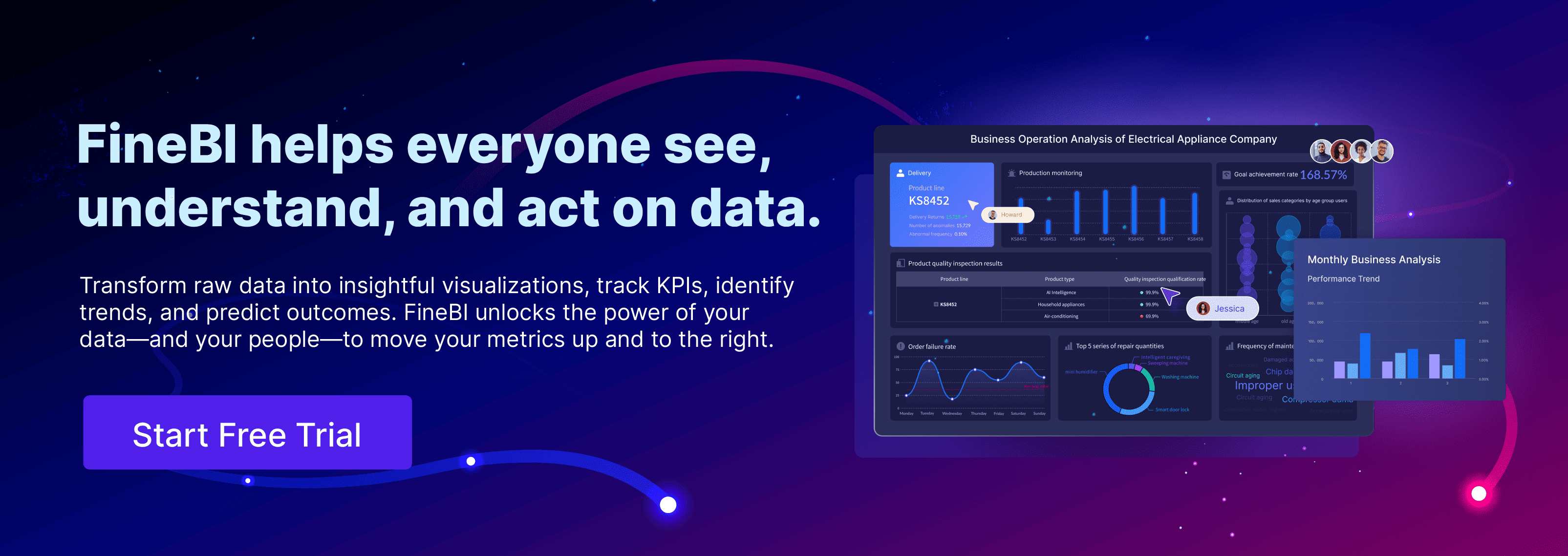
Continue Reading About Data Analysis
How to Fix Data Analysis Excel Not Showing in 2025
What is SaaS Analytics and Why Businesses Need It
Top Beginner-Friendly Data Analysis Projects to Build Your Portfolio
Data Analysis vs Data Analytics: What’s the Real Difference?
FAQ

The Author
Lewis
Senior Data Analyst at FanRuan
Related Articles

11 Best Tools for Research Analysis for Academics
Compare the 11 best tools for research analysis to boost academic and professional research efficiency, data management, and collaboration.
Lewis
Dec 11, 2025

10 Best Market Research Data Analysis Tools to Try This Year
See the top 10 market research data analysis tools to boost insights, streamline workflows, and make smarter business decisions this year.
Lewis
Dec 11, 2025

Top Financial Data Analysis Tools You Should Know
Compare top financial data analysis tools to boost accuracy, automate reporting, and empower your finance team with real-time business insights.
Lewis
Dec 11, 2025
